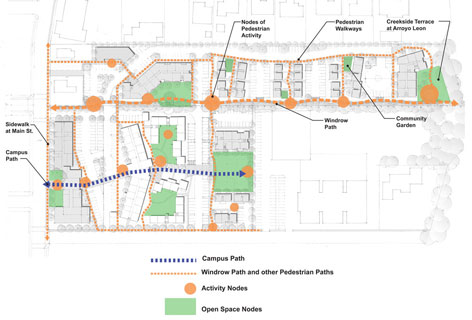

The Moon Village master plan is an architectural concept for a sustainable, international human outpost on the rim of Shackleton Crater near the lunar South Pole. Additionally, we overview some of the novel materials with outstanding properties, such as low weight, increased radiation resistance, and self-healing capabilities with a potential to reduce mission costs and improve prospects for extended human exploration of extraterrestrial bodies. We then discuss selected studies of radiation damage in materials of importance and potential use for the exploration and settlement on the Moon, ranging from semiconductors to alloys and from polymers to the natural regolith. We focus on cumulative displacement effects induced by radiation below the regime of hadronic interactions. In this chapter, after introducing the Monte Carlo particle transport method, we present a multiscale approach to study different stages of radiation damage which allows for the synergy between the electronic and nuclear effects induced in materials. However, radiation damage is a multiscale problem, both in time and in length, an aspect treated by the Monte Carlo simulations only to a limited extent. Monte Carlo particle transport simulations are the most common approach for modeling radiation damage in materials. Energetic charged particles impacting materials create electronic excitations, atomic displacements, and nuclear fragmentation. Understanding the effect of radiation on materials is fundamental for space exploration. In one example, AAA provides up to a 45% increase in the exposed area of unshaded panels compared with each panel facing the Sun at a perpendicular angle. Two automatic panel control strategies are proposed for circular array configurations: Automatic Elevation Control makes is possible to achieve maximum panel exposure using two elevation levels, while Automatic Angle Adjustment (AAA) addresses the problem of partial panel shading by rotating some panels away from the solar incidence angle in order to avoid shadowing from other panels.

The previous study is therefore extended in this paper by studying arrays with panels that can have different fixed or actuated elevations, in order to find favorable configurations to increase average solar exposure during a simulated lunar day. Using panels with different elevations, however, offers the possibility of increasing solar panel exposure for a given ground deployment area. One simplifying assumption was the use of panels at the same elevation in each array. A previous study by the authors identified favorable spatial configurations of vertically-oriented solar panels which increased the average exposed total panel area while minimizing the number of panels or total panel area. For an array of several solar panels deployed in a ground area, panels currently facing the Sun would cast long shadows, possibly occluding other panels behind. One challenge, however, is that the Sun remains near the horizon during the lunar daily cycle. The project location has been determined to receive nearly continuous sunlight throughout the lunar year, offering the potential for nearly continuous solar power generation. The Moon Village master plan by Skidmore, Owings & Merrill and the European Space Agency is a concept for a permanent human settlement near the lunar South Pole, on the rim of Shackleton Crater.


 0 kommentar(er)
0 kommentar(er)
